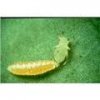Several species, Family Syrphidae
Adults of this large group of flies a feed on nectar and pollen of flowers, and pollinate plants. Many are brightly colored and resemble bees or wasps. Most species hover motionless except for beating their wings; others fly with a buzzing sound like bees.
This is one of the most beneficial groups of insects in the yard and garden. Adult stages of these insects are usually colored bright orange or yellow and black. Most resemble bees and wasps, and some even carry this act to convincing extremes by buzzing. However, adult syrphid flies (sometimes called “flower flies” or “hover flies”) are harmless, feeding on nectar and pollen. Syrphid fly larvae vary considerably in appearance and biology. They are 6 to 19 mm long (about 1/4 to 3/4 inch long), elongated, legless, and slug-like. Their bodies are pointed at the head, blunt or broad at the tail end, and somewhat depressed. Many are yellow, pink, green, or brown marked with black or white. Take a look at the picture of a larvae below

The larvae are commonly found among aphid colonies and move slowly over surfaces of plants, using their pointed jaws to grab aphids and suck out the body contents before discarding the aphid skins. Syrphid fly larvae can consume one aphid per minute. Adults lay glistening white, elongated eggs among colonies of aphids.
How do you tell the difference between a fly and a bee? Here are a few differences:
- Wings: Flies have 2; bees have 4.
- Antennae: Flies have stubby antennae; bees have long.
- Eyes: Flies have big compound eyes; bees have simple eyes.
If you see a bee hovering about like a little helicopter, look again. Chances are that this little fellow has only 2 wings, stubby antennae, and big eyes. So, why does he look like a bee? That's his clever disguise. Birds will not eat him for fear of getting stung. You don't need to worry, however, as these little syrphid flies cannot sting.
Is the Syrphid Fly a Good Bug or a Bad Bug?
This guy is good! Not only are they great pollinators, but the little maggots are real pigs when it comes to munching aphids.
Adults lay eggs on aphid infested leaves and within 2 or 3 days, a tiny green maggot hatches. These little maggots are blind so they have to tap their head around until they find an aphid. Then a hook comes out, grabs the aphid, and pulls it against its mouth to suck the juice right out. The maggots are tiny when they first hatch, but after 3 or 4 weeks of feeding, they are almost too fat to balance on a leaf. They then drop to the soil where they pupate emerging as adults in about 2 weeks.
You should see syphid flies hovering about in the summer. You'll probably say, "I always wondered what those weird bees are."
Pollen or nectar rich plants such as yarrow, lovage or fennel will help attract syrphid flies to your yard.







